- Регистрация
- 17 Февраль 2018
- Сообщения
- 23 686
- Лучшие ответы
- 0
- Баллы
- 2 093
Offline
Competitive gaming can feel like an Olympic-sized endeavor for many. It demands time, dedication, practice, grit, and mental fortitude. You have to cultivate success from many angles — and part of that involves making sure your network isn’t impeding your performance.
The best online esports gamer in the world with a top-tier gaming rig is still at the mercy of one vital bottleneck: network latency.
When playing competitively online, ping or lag or latency (whatever you want to call it) can turn a winning move into a disaster. You need every millisecond you can get for your reaction time and cat-like reflexes, otherwise your opponents will have an advantage over you.
As a competitive PC gamer myself, I know this all too well. Here are my best tips for how to lower your latency in online games, whether you’re a casual gamer or have dreams of an esports future.
Tip #1: Kill network-hogging apps
One thing you need to be mindful of when playing online games is that the game isn’t the only thing sending and receiving data. Most of the other apps on your system — and the operating system itself — are likely dealing with their own network data.
Of course, a lot of those apps aren’t hogging your network. They’re probably using a few megabytes here and there, so nothing to be concerned about. But there are a few heavy-hitting apps to be aware of, and you’ll want to exit them before you game.
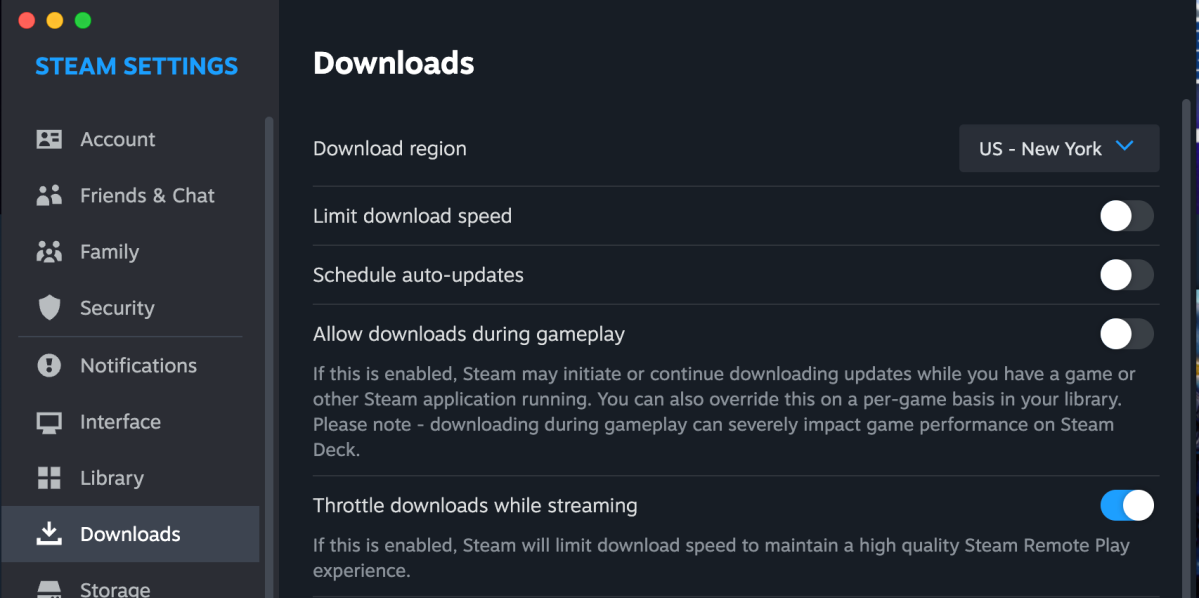
Thiago Trevisan / IDG
Thiago Trevisan / IDG
Thiago Trevisan / IDG
For example, game launchers like Steam, Epic Games Store, and even Microsoft Store might end up downloading games and updates in the background. (Nothing will tank your in-game network performance faster than an active download!) Look in the settings for a way to disable downloads during gameplay.
Streaming services like YouTube and Netflix are also common culprits. It takes a lot of data to serve streaming video, especially if you’re watching in 1080p or 4K. Yeah, you might prefer to have something playing in the background, but just know that it’s affecting your bandwidth.

Thiago Trevisan / IDG
Thiago Trevisan / IDG
Thiago Trevisan / IDG
Torrenting is the third common major culprit as far as reasons why your ping might be laggy in online games. Always make sure you haven’t accidentally left your torrents on in the background.
And, of course, you also want to make sure that no one else on the network is doing any of these things. Your partner who’s streaming 4K episodes and your sibling who’s torrenting are affecting the network all the same. (You can kind of mitigate this with a properly configured router. More on this below in Tip #3.)
Tip #2: Benchmark your network speeds
Ping and latency are recorded in milliseconds (ms). For best performance, you want to have less than 20 ms of latency in online games, but that may not be possible due to server distance or network equipment limits. You can have close-to-ideal performance under 50 ms, while 100 ms is about the limit of playability. Above 100 ms, lag and network artifacts are increasingly more likely to impact gameplay.
Readily-available internet speed tests are a quick, easy, and free way to test your download and upload speeds while also seeing your ping and latency to the test server. This is good for establishing a reference point before you make adjustments to your home network.
A few terms worth knowing:
You basically want the lowest numbers for latency, else you’ll run into lag and disruptions while gaming (and while doing anything else that’s network-intensive, like video chatting, streaming, etc.).
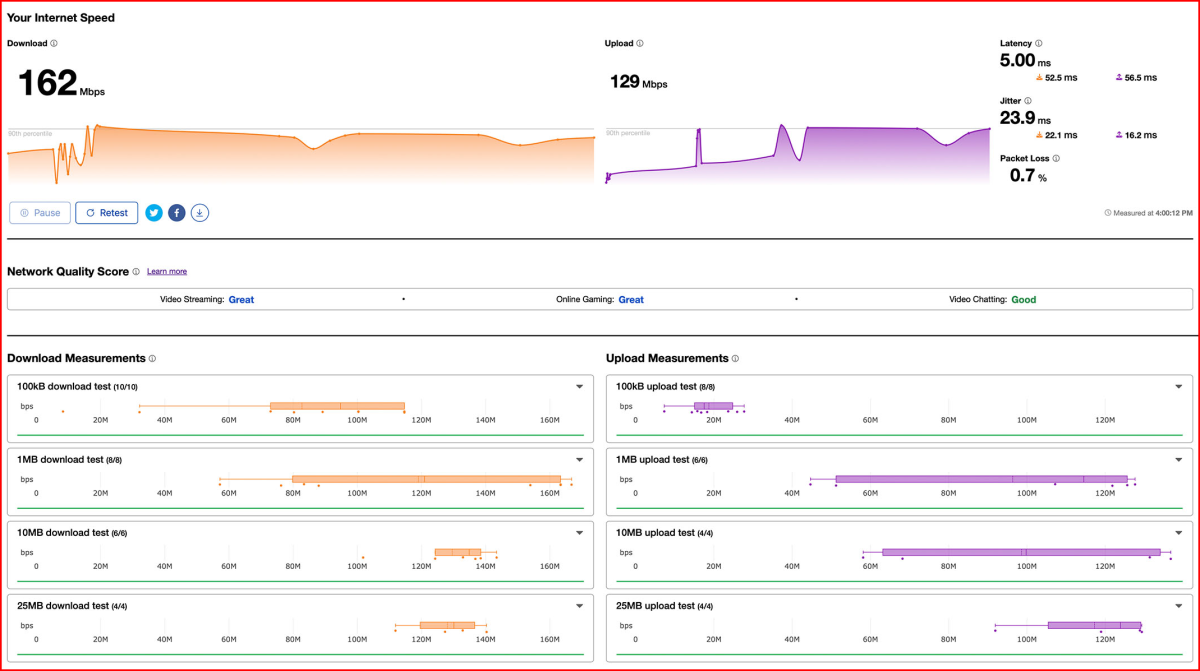
Cloudflare network speed test results on a wireless office network.
Cloudflare network speed test results on a wireless office network.
Thiago Trevisan / IDG
Cloudflare network speed test results on a wireless office network.
Thiago Trevisan / IDG
Thiago Trevisan / IDG
In-game tools are also commonly available to let you know what your ping is. You can test with a wireless connection and then switch to Ethernet to more scientifically calculate any differences. Every connection is different, so this can be a good way to see how your specific connection behaves in your environment.
Tip #3: Tweak your router settings
For the most part, network latency is mostly influenced by your ISP, your internet connection type, your network equipment, and your distance to game servers. It’s important to make sure your network equipment (e.g., router) isn’t causing a bottleneck somehow.
If you’re gaming on a Wi-Fi connection, stick to 5GHz bands instead of 2.4GHz bands. 5GHz is generally faster and has less interference. (If you can get a router with 6GHz bands, that’ll be even better.) You may have to manually enable 5GHz for your router, so make sure it’s on (and make sure you’re connected to the 5GHz network.)
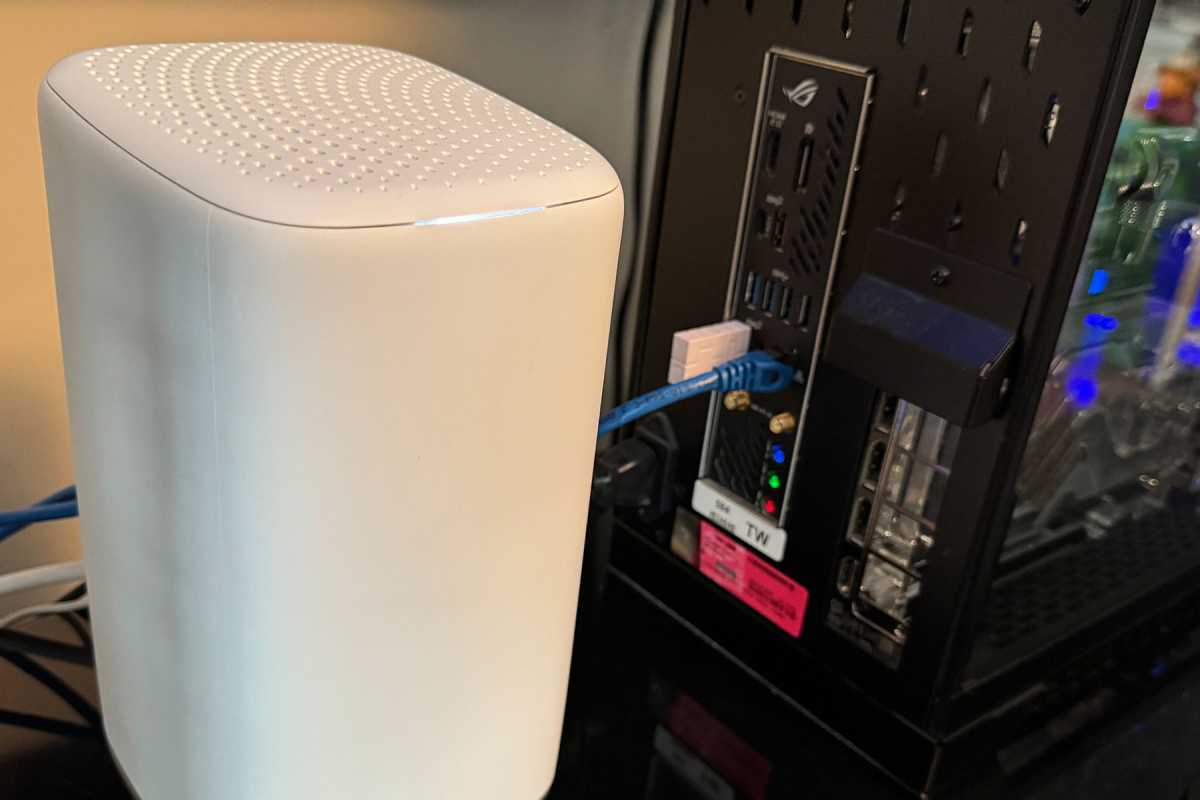
Thiago Trevisan / IDG
Thiago Trevisan / IDG
Thiago Trevisan / IDG
Your router may also have a setting called Nagle’s Algorithm, which basically bundles together network data packets before sending them out (as opposed to sending them out individually as they’re ready). This has its benefits, but it can increase your latency. If it’s enabled in your router, try disabling it to see if it has a measurable impact on your gaming.
Quality of Service (QoS) is another router feature that can aid with connection quality. In a nutshell, QoS lets you prioritize the most important activities on your network (e.g., gaming) so that those data packets are always processed first. For example, if you’re playing a game and someone else is downloading a large file, your router’s QoS can prioritize your gaming traffic over their download traffic.
You can further push network priority to devices on wired connections over wireless connections to ensure best latency. (See below Tip #6 for more on why you should use a wired connection.)
Some gaming routers have “gaming modes” that handle all of this for you automatically, making it easier to optimize network latency without being an expert yourself. Gaming modes can typically be found in the router’s admin panel or BIOS settings.
And speaking of the BIOS, make sure your router firmware is updated to maximize stability and benefit from improvements.
Tip #4: Optimize your network routing
Network packets travel at the speed of light, which means your latency is limited by the laws of physics. The farther your data packets have to travel, the higher the latency — no way around that.
Which means the physical distance between your machine and the game server is very important. If the game lets you choose between multiple servers, always choose the one that’s closest to you.

My ping level in Quake Champions on a moderately distant server.
My ping level in Quake Champions on a moderately distant server.
Thiago Trevisan / IDG
My ping level in Quake Champions on a moderately distant server.
Thiago Trevisan / IDG
Thiago Trevisan / IDG
The amount of servers available to you will depend on a lot of factors, though. Popular games may run a lot of servers all over the world while lesser-known indie games may only have a couple. If you’re in the US, you’ll have more options than someone in Australia. (Sad but true.) All of this is beyond your control.
However, if you have high latency on a relatively close server or if you don’t have any server options near you, what can you do?
There are some VPN services out there that promise to reduce gaming lag by providing a special networks with optimized routing. For example, WTFast uses machine learning to find optimized paths between your network and gaming servers, which might help in some cases to reduce latency, reduce packet loss, and improve stability.
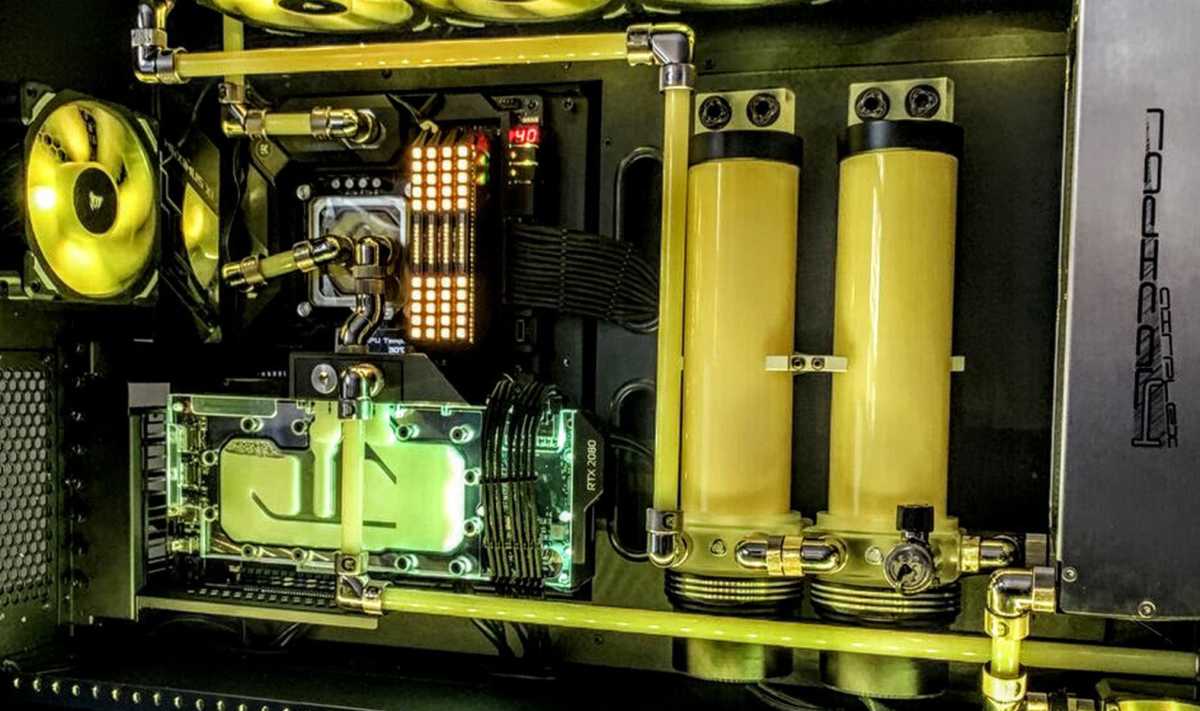
Your gaming rig won’t save you if your network isn’t robust!
Your gaming rig won’t save you if your network isn’t robust!
Thiago Trevisan / IDG
Your gaming rig won’t save you if your network isn’t robust!
Thiago Trevisan / IDG
Thiago Trevisan / IDG
If you already have good network routing, these kinds of services probably won’t do much for you. They’re mainly for extreme situations, like if you live in a remote area with underdeveloped broadband. Your mileage may vary.
Tip #5: Improve your Wi-Fi network
Wi-Fi performance has improved tremendously over the last several years. With the newer Wi-Fi 7 standard hitting the market, you can get unprecedented speed and latency. Many routers also support multiple bands, helping to mitigate issues with interference in busy areas.

Good wireless gaming performance is possible, but you’ll need a solid router.
Good wireless gaming performance is possible, but you’ll need a solid router.
Thiago Trevisan / IDG
Good wireless gaming performance is possible, but you’ll need a solid router.
Thiago Trevisan / IDG
Thiago Trevisan / IDG
But if you can’t afford to get a fancy router, there are some other optimizations worth trying. Tweaking your wireless network channel can mitigate interference and congestion, while elevating your router and moving it to a central spot can reduce interference further. Proximity to your wireless router matters a lot, too, and you should be able to secure a stronger signal just by moving closer to it.
If your main issue with Wi-Fi has to do with spotty connections and inconsistent performance, you might consider something like a Wi-Fi extender or even going with a wireless mesh system. However, there’s a trade-off: in exchange for a more stable connection, you might experience slightly higher latency. That might be worth it if your ping is constantly spiking due to shoddy signal.
Tip #6: Use a wired Ethernet connection
While I’m a huge fan of Wi-Fi for everyday use because it’s just so convenient, it has its flaws and quirks — and if you need every last bit of network performance in your competitive games, then you should reconsider using Wi-Fi while gaming online.
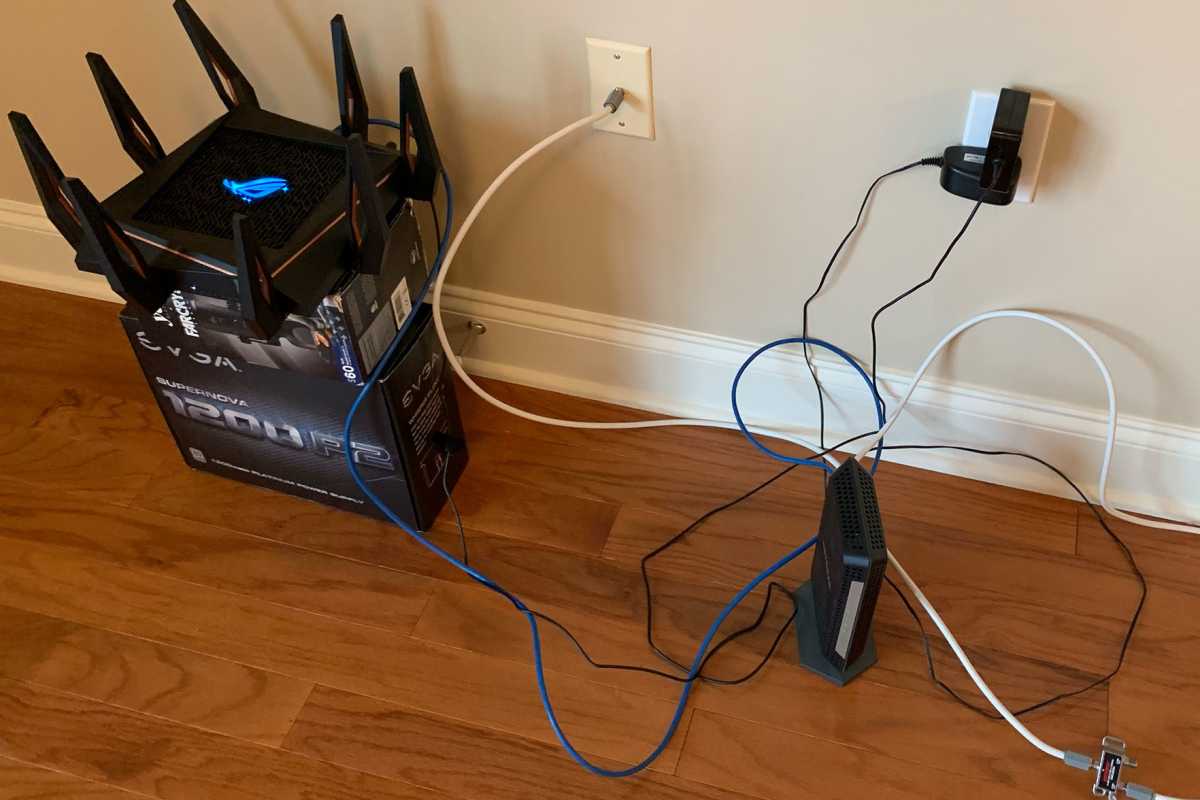
Thiago Trevisan / IDG
Thiago Trevisan / IDG
Thiago Trevisan / IDG
Switching to a wired Ethernet connection is the best way to eliminate potential issues with Wi-Fi and get faster internet speeds. Plus, it’s cost effective and cheaper than a pricey gaming wireless router.
With wired Ethernet, you don’t have to worry about wireless signal drops or interference from other wireless devices cluttering up the space. Sure, cable interference is also a thing, but it’s way less common and can be mitigated with high-quality Ethernet cables.

Thiago Trevisan / IDG
Thiago Trevisan / IDG
Thiago Trevisan / IDG
More importantly, Ethernet is faster than Wi-Fi in most cases. As of this writing, a CAT 8 Ethernet cable can theoretically deliver up to 40Gbps while Wi-Fi 6 can theoretically deliver up to 9.6Gbps. In real-world usage, Wi-Fi transmissions rarely operate anywhere close to max speed; meanwhile, Ethernet connections are more stable.
There are even specialized fiber-optic cables on the market for the most serious of esports gamers, and these cables allow for faster data transmission compared to typical copper cables. But they’re more expensive and have diminishing benefits. For most gamers, a standard Ethernet cable is more than enough.
Tip #7: Upgrade your ISP plan
The latest and greatest Wi-Fi and Ethernet technologies mean nothing if the internet service to your house is poor OR if your network router is too weak to process that much data quickly enough.
If you’re paying peanuts to your ISP for the budget-tier 150Mbps plan, then you don’t have much to work with. And same goes if you’re still on a cheap, years-old “Fast Ethernet” router that maxes out at 100Mbps. Your internet speed is limited by the slowest bottleneck in your network — and in this example, you’d be stuck with 100Mbps on either Wi-Fi or Ethernet.
To be fair, 100Mbps could be enough for online gaming. But if you have a lot of devices connected to your router, they could be clogging up network traffic and causing slowdowns. That’s when it’s worth paying for a higher ISP plan and/or upgrading to a better router.
Your internet service type can also affect latency. For example, satellite internet is terrible for gaming because of the way the technology works: your data has to bounce off satellites in space to reach its destination, then bounce back off those satellites to return to you. That’s why satellite connections have much higher latency.
If possible, switch to an ISP with a dedicated fiber-optic line. Cable internet is the next best thing. DSL internet can be a last resort.
Tip #8: Upgrade your router
Now, if you have a high-speed multi-gig ISP plan, make sure you also have an advanced router that’s capable of delivering those speeds to all the devices on your network. (No point paying for 1Gbps internet if your network traffic is just going to be throttled by a dumpy router.)

This Asus ROG wireless router has a dedicated gaming port.
This Asus ROG wireless router has a dedicated gaming port.
Asus
This Asus ROG wireless router has a dedicated gaming port.
Asus
Asus
Some high-end routers, such as the Asus ROG Rapture GT-BE98 Pro, even have a dedicated 10Gbps LAN port with a “Game Boost” feature that prioritizes your gaming connection and helps ensure the fastest speeds and minimal latency, especially when network traffic is congested.
Advanced wireless routers, such as the Asus ROG AX11000, also typically have more antennas. These extra antennas allow the router to more easily split Wi-Fi bands between 2.4GHz and 5GHz. They also tend to include more gaming-focused settings to tweak within their admin panels, too.

A wireless gaming router with branded Call of Duty packaging.
A wireless gaming router with branded Call of Duty packaging.
Thiago Trevisan / IDG
A wireless gaming router with branded Call of Duty packaging.
Thiago Trevisan / IDG
Thiago Trevisan / IDG
The quality of your router matters a lot more for wireless connections than it does for Ethernet connections, so consider splurging on the best router your budget allows — one that at least has Wi-Fi 6, supports multiple bands, and can handle your ISP plan’s speeds.
The best online esports gamer in the world with a top-tier gaming rig is still at the mercy of one vital bottleneck: network latency.
When playing competitively online, ping or lag or latency (whatever you want to call it) can turn a winning move into a disaster. You need every millisecond you can get for your reaction time and cat-like reflexes, otherwise your opponents will have an advantage over you.
As a competitive PC gamer myself, I know this all too well. Here are my best tips for how to lower your latency in online games, whether you’re a casual gamer or have dreams of an esports future.
Tip #1: Kill network-hogging apps
One thing you need to be mindful of when playing online games is that the game isn’t the only thing sending and receiving data. Most of the other apps on your system — and the operating system itself — are likely dealing with their own network data.
Of course, a lot of those apps aren’t hogging your network. They’re probably using a few megabytes here and there, so nothing to be concerned about. But there are a few heavy-hitting apps to be aware of, and you’ll want to exit them before you game.

Thiago Trevisan / IDG
Thiago Trevisan / IDG
Thiago Trevisan / IDG
For example, game launchers like Steam, Epic Games Store, and even Microsoft Store might end up downloading games and updates in the background. (Nothing will tank your in-game network performance faster than an active download!) Look in the settings for a way to disable downloads during gameplay.
Streaming services like YouTube and Netflix are also common culprits. It takes a lot of data to serve streaming video, especially if you’re watching in 1080p or 4K. Yeah, you might prefer to have something playing in the background, but just know that it’s affecting your bandwidth.

Thiago Trevisan / IDG
Thiago Trevisan / IDG
Thiago Trevisan / IDG
Torrenting is the third common major culprit as far as reasons why your ping might be laggy in online games. Always make sure you haven’t accidentally left your torrents on in the background.
And, of course, you also want to make sure that no one else on the network is doing any of these things. Your partner who’s streaming 4K episodes and your sibling who’s torrenting are affecting the network all the same. (You can kind of mitigate this with a properly configured router. More on this below in Tip #3.)
Tip #2: Benchmark your network speeds
Ping and latency are recorded in milliseconds (ms). For best performance, you want to have less than 20 ms of latency in online games, but that may not be possible due to server distance or network equipment limits. You can have close-to-ideal performance under 50 ms, while 100 ms is about the limit of playability. Above 100 ms, lag and network artifacts are increasingly more likely to impact gameplay.
Readily-available internet speed tests are a quick, easy, and free way to test your download and upload speeds while also seeing your ping and latency to the test server. This is good for establishing a reference point before you make adjustments to your home network.
A few terms worth knowing:
- Round Trip Time (RTT) is how fast a network data packet can be sent from your network to a server and then back.
- Jitter is how much variation there is in RTT, based on an averaging of results. This gives a more accurate picture of latency.
- Packet loss refers to how many network data packets never reach their destination, requiring them to be resent. This can drastically affect jitter if it’s frequent.
You basically want the lowest numbers for latency, else you’ll run into lag and disruptions while gaming (and while doing anything else that’s network-intensive, like video chatting, streaming, etc.).

Cloudflare network speed test results on a wireless office network.
Cloudflare network speed test results on a wireless office network.
Thiago Trevisan / IDG
Cloudflare network speed test results on a wireless office network.
Thiago Trevisan / IDG
Thiago Trevisan / IDG
In-game tools are also commonly available to let you know what your ping is. You can test with a wireless connection and then switch to Ethernet to more scientifically calculate any differences. Every connection is different, so this can be a good way to see how your specific connection behaves in your environment.
Tip #3: Tweak your router settings
For the most part, network latency is mostly influenced by your ISP, your internet connection type, your network equipment, and your distance to game servers. It’s important to make sure your network equipment (e.g., router) isn’t causing a bottleneck somehow.
If you’re gaming on a Wi-Fi connection, stick to 5GHz bands instead of 2.4GHz bands. 5GHz is generally faster and has less interference. (If you can get a router with 6GHz bands, that’ll be even better.) You may have to manually enable 5GHz for your router, so make sure it’s on (and make sure you’re connected to the 5GHz network.)

Thiago Trevisan / IDG
Thiago Trevisan / IDG
Thiago Trevisan / IDG
Your router may also have a setting called Nagle’s Algorithm, which basically bundles together network data packets before sending them out (as opposed to sending them out individually as they’re ready). This has its benefits, but it can increase your latency. If it’s enabled in your router, try disabling it to see if it has a measurable impact on your gaming.
Quality of Service (QoS) is another router feature that can aid with connection quality. In a nutshell, QoS lets you prioritize the most important activities on your network (e.g., gaming) so that those data packets are always processed first. For example, if you’re playing a game and someone else is downloading a large file, your router’s QoS can prioritize your gaming traffic over their download traffic.
You can further push network priority to devices on wired connections over wireless connections to ensure best latency. (See below Tip #6 for more on why you should use a wired connection.)
Some gaming routers have “gaming modes” that handle all of this for you automatically, making it easier to optimize network latency without being an expert yourself. Gaming modes can typically be found in the router’s admin panel or BIOS settings.
And speaking of the BIOS, make sure your router firmware is updated to maximize stability and benefit from improvements.
Tip #4: Optimize your network routing
Network packets travel at the speed of light, which means your latency is limited by the laws of physics. The farther your data packets have to travel, the higher the latency — no way around that.
Which means the physical distance between your machine and the game server is very important. If the game lets you choose between multiple servers, always choose the one that’s closest to you.

My ping level in Quake Champions on a moderately distant server.
My ping level in Quake Champions on a moderately distant server.
Thiago Trevisan / IDG
My ping level in Quake Champions on a moderately distant server.
Thiago Trevisan / IDG
Thiago Trevisan / IDG
The amount of servers available to you will depend on a lot of factors, though. Popular games may run a lot of servers all over the world while lesser-known indie games may only have a couple. If you’re in the US, you’ll have more options than someone in Australia. (Sad but true.) All of this is beyond your control.
However, if you have high latency on a relatively close server or if you don’t have any server options near you, what can you do?
There are some VPN services out there that promise to reduce gaming lag by providing a special networks with optimized routing. For example, WTFast uses machine learning to find optimized paths between your network and gaming servers, which might help in some cases to reduce latency, reduce packet loss, and improve stability.

Your gaming rig won’t save you if your network isn’t robust!
Your gaming rig won’t save you if your network isn’t robust!
Thiago Trevisan / IDG
Your gaming rig won’t save you if your network isn’t robust!
Thiago Trevisan / IDG
Thiago Trevisan / IDG
If you already have good network routing, these kinds of services probably won’t do much for you. They’re mainly for extreme situations, like if you live in a remote area with underdeveloped broadband. Your mileage may vary.
Tip #5: Improve your Wi-Fi network
Wi-Fi performance has improved tremendously over the last several years. With the newer Wi-Fi 7 standard hitting the market, you can get unprecedented speed and latency. Many routers also support multiple bands, helping to mitigate issues with interference in busy areas.

Good wireless gaming performance is possible, but you’ll need a solid router.
Good wireless gaming performance is possible, but you’ll need a solid router.
Thiago Trevisan / IDG
Good wireless gaming performance is possible, but you’ll need a solid router.
Thiago Trevisan / IDG
Thiago Trevisan / IDG
But if you can’t afford to get a fancy router, there are some other optimizations worth trying. Tweaking your wireless network channel can mitigate interference and congestion, while elevating your router and moving it to a central spot can reduce interference further. Proximity to your wireless router matters a lot, too, and you should be able to secure a stronger signal just by moving closer to it.
If your main issue with Wi-Fi has to do with spotty connections and inconsistent performance, you might consider something like a Wi-Fi extender or even going with a wireless mesh system. However, there’s a trade-off: in exchange for a more stable connection, you might experience slightly higher latency. That might be worth it if your ping is constantly spiking due to shoddy signal.
Tip #6: Use a wired Ethernet connection
While I’m a huge fan of Wi-Fi for everyday use because it’s just so convenient, it has its flaws and quirks — and if you need every last bit of network performance in your competitive games, then you should reconsider using Wi-Fi while gaming online.

Thiago Trevisan / IDG
Thiago Trevisan / IDG
Thiago Trevisan / IDG
Switching to a wired Ethernet connection is the best way to eliminate potential issues with Wi-Fi and get faster internet speeds. Plus, it’s cost effective and cheaper than a pricey gaming wireless router.
With wired Ethernet, you don’t have to worry about wireless signal drops or interference from other wireless devices cluttering up the space. Sure, cable interference is also a thing, but it’s way less common and can be mitigated with high-quality Ethernet cables.

Thiago Trevisan / IDG
Thiago Trevisan / IDG
Thiago Trevisan / IDG
More importantly, Ethernet is faster than Wi-Fi in most cases. As of this writing, a CAT 8 Ethernet cable can theoretically deliver up to 40Gbps while Wi-Fi 6 can theoretically deliver up to 9.6Gbps. In real-world usage, Wi-Fi transmissions rarely operate anywhere close to max speed; meanwhile, Ethernet connections are more stable.
There are even specialized fiber-optic cables on the market for the most serious of esports gamers, and these cables allow for faster data transmission compared to typical copper cables. But they’re more expensive and have diminishing benefits. For most gamers, a standard Ethernet cable is more than enough.
Tip #7: Upgrade your ISP plan
The latest and greatest Wi-Fi and Ethernet technologies mean nothing if the internet service to your house is poor OR if your network router is too weak to process that much data quickly enough.
If you’re paying peanuts to your ISP for the budget-tier 150Mbps plan, then you don’t have much to work with. And same goes if you’re still on a cheap, years-old “Fast Ethernet” router that maxes out at 100Mbps. Your internet speed is limited by the slowest bottleneck in your network — and in this example, you’d be stuck with 100Mbps on either Wi-Fi or Ethernet.
To be fair, 100Mbps could be enough for online gaming. But if you have a lot of devices connected to your router, they could be clogging up network traffic and causing slowdowns. That’s when it’s worth paying for a higher ISP plan and/or upgrading to a better router.
Your internet service type can also affect latency. For example, satellite internet is terrible for gaming because of the way the technology works: your data has to bounce off satellites in space to reach its destination, then bounce back off those satellites to return to you. That’s why satellite connections have much higher latency.
If possible, switch to an ISP with a dedicated fiber-optic line. Cable internet is the next best thing. DSL internet can be a last resort.
Tip #8: Upgrade your router
Now, if you have a high-speed multi-gig ISP plan, make sure you also have an advanced router that’s capable of delivering those speeds to all the devices on your network. (No point paying for 1Gbps internet if your network traffic is just going to be throttled by a dumpy router.)

This Asus ROG wireless router has a dedicated gaming port.
This Asus ROG wireless router has a dedicated gaming port.
Asus
This Asus ROG wireless router has a dedicated gaming port.
Asus
Asus
Some high-end routers, such as the Asus ROG Rapture GT-BE98 Pro, even have a dedicated 10Gbps LAN port with a “Game Boost” feature that prioritizes your gaming connection and helps ensure the fastest speeds and minimal latency, especially when network traffic is congested.
Advanced wireless routers, such as the Asus ROG AX11000, also typically have more antennas. These extra antennas allow the router to more easily split Wi-Fi bands between 2.4GHz and 5GHz. They also tend to include more gaming-focused settings to tweak within their admin panels, too.

A wireless gaming router with branded Call of Duty packaging.
A wireless gaming router with branded Call of Duty packaging.
Thiago Trevisan / IDG
A wireless gaming router with branded Call of Duty packaging.
Thiago Trevisan / IDG
Thiago Trevisan / IDG
The quality of your router matters a lot more for wireless connections than it does for Ethernet connections, so consider splurging on the best router your budget allows — one that at least has Wi-Fi 6, supports multiple bands, and can handle your ISP plan’s speeds.
